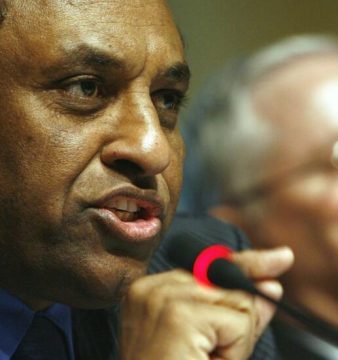What is Behind #BlueForSudan?
People are changing their profile pictures on social media to the colour blue in solidarity with Sudan and to honour those killed by paramilitary forces in the Khartoum massacre on 3 June 2019.
Many notable figures have called on people to change their profile pictures to blue in solidarity with Sudan, using hashtags #BlueforSudan #PaintSudanBlue and #PrayforSudan.
Stand with humanity, stand with Sudan— show solidarity by turning your profile to the colour blue! #BlueForSudan pic.twitter.com/75sunwBjBn
— Al Mayassa Al Thani (@almayassahamad) June 12, 2019
Screenshot this #NewProfilePic and make it your own #paintSudanblue to tell the world our story #IAmTheSudanRevlotion pic.twitter.com/100gAaRXUb
— ود البيه (@khalidalbaih) June 12, 2019
ناشطون من جنسيات مختلفة وشخصيات عامة يدشنون حملة #BlueForSudan للتضامن مع الشعب السوداني، بتغيير صورهم الشخصية على مواقع التواصل إلى هذا اللون.#العصيان_المدني_الشامل #Sudan_internet_blackout#نناضل_لا_نساوم pic.twitter.com/bwJpgB8Mli
— Hosam Yahia (@HosamYahiaAJ) June 12, 2019
Our hearts go out to the people of Sudan. Stay strong and persevere 💙
Art by Emad Hajjaj for Alaraby Aljadeed newspaper https://t.co/LBeyuHuk5I#Sudan #BlueForSudan #StandWithSudan #Khartoum #SudanRevolution #Doha #Qatar #iloveqatar #ilq #love #peace #kindness #humanity pic.twitter.com/zfxxIlIi5j
— ILoveQatar – Live (@ILQLive) June 12, 2019
Go blue for #Sudan 🇸🇩✊🏽❤️🙏🏽 #BlueForSudan #PrayforSudan #NewProfilePic pic.twitter.com/d3iaZd25oo
— Meron Estefanos (@meronina) June 12, 2019
Why blue?
The blue colour originated from the profile pictures of Mohamed Hashim Mattar’s Twitter and Instagram accounts – a dark shade of blue. Mattar, 26, was one of the more than 100 people who were killed in the Khartoum massacre on 3 June 2019. Reports say Mattar succumbed to facial bullet wounds when he attempted to shield a couple of women as Rapid Support Forces (RSF) opened fire at peaceful protesters in the mass sit-in in Khartoum. After news of Mattar’s death broke out, those close to him changed their profile pictures to the same shade of blue, paying homage to him. However, it has now become the symbol to honour and pay tribute to all of the martyrs of the Khartoum massacre.
The color blue, one of our martyrs (Mattar) favorite color, started as a tribute to him, now turned to a symbol of all our martyrs, and their dreams of a better Sudan.#BlueForSudan#IAmSudaneseRevolution https://t.co/3LMxrtBOvi
— Saad The Lion سعد (@Saad_Alasad) June 12, 2019
#Sudan 🇸🇩: one of the protesters who was murdered by the #RSF at the sit-in was Mohamed Hashim Mattar. He died trying to shield a couple of women.
In the picture Mohamed is celebrating his birthday, it was taken just two hours before he was killed.#SudanUprising #SudanMassacre pic.twitter.com/jXlT1IvL1l
— Thomas van Linge (@ThomasVLinge) June 5, 2019
This year Eid was stolen from Sudan. May justice be served for all the martyrs. Your death is not in vain, you live on through us and we’ve only just begun. Rest In Peace Mohamed Hashim Mattar and the countless other brave souls. دم الشهيد ما راح #sudanrevolts 🇸🇩 pic.twitter.com/p4PExIAMhg
— Yousra (@yousrabashir) June 4, 2019
Born on 2 June 1993, Mattar was pursuing a master’s degree in engineering management at Brunel University London in the UK and was set to graduate in 2020. He traveled to Khartoum on 23 April 2019 to attend a family occasion and since his return, has participated in several anti-government protests.
يقول الشهيد محمد هاشم مطر :حرام علينا لو دم الشهيد راح
ربنا يرحمك يا مطر يا وطن 😔#مجزرة_القيادة_العامة pic.twitter.com/nWquRfr1XF— mohamed albadri (@wdalbadri93) June 7, 2019
They killed Mr. Nuslang and for what? Only for us to come back stronger.
We are millions of Mattars.
We are millions of Watans.
Today we mourn you, and today we continue the fight to avenge our martyrs.Rest in power our beloved Mattar pic.twitter.com/V1A6Q2uaRJ
— nuslang. (@nuslang_) June 3, 2019
Our deepest condolences to the family of the late Muhammad Hashim Matar.
Matar was considered a family member of Capital Radio, with a great loving heart and positive vibe. Always pushing the team forward.
We are deeply saddened by your loss.
You’ll always be remembered. pic.twitter.com/l0fJZTFbWX— Capital Radio 91.6 FM (@Capital916FM) June 3, 2019
There are a few shades of blue circulating. However, the blue to the left is the original shade of blue from Mattar’s profile pictures on Instagram and Twitter.
What happened in the Khartoum massacre?
At dawn on Monday, 3 June and the 29th day of the holy month of Ramadan, Rapid Support Forces (RSF) and other paramilitary forces raided the monthslong mass sit-in in Al Qeyada in front of the headquarters of the Sudanese Armed Forces (SAF), leaving at least 100 dead and more than 300 injured. At least 40 bodies were pulled of the Nile River where paramilitary forces attempted to dispose of the dead bodies. In addition, residents reported rapes and robberies at the hands of paramilitary forces. Others have been arrested, brutally beaten and even urinated on. The ruling Transitional Military Council (TMC) has cut off almost all internet and phone services since the brutal raid, which took place on 3 June 2019.
What is happening in Sudan?
The protests first began in December 2018, triggered by a hike in prices of basic commodities such as bread and fuel shortages, and quickly led to thousands of protesters taking to the streets across Sudan, calling for the downfall of the former Sudanese president Omar Al Bashir and his regime. Government forces have responded to protests with live ammunition, rubber bullets and tear gas. Since December 2018, more than 200 people have been killed, hundreds injured and more than 1,000 arrested.
On 6 April, ten of thousands of protesters marched to the HQ of SAF and camped there, demanding the step down of Al Bashir and his regime. On 11 April, Al Bashir was overthrown by the military. Since the ousting of Al Bashir, the TMC has been ruling, led by Lieutenant General Abdel Fattah Abdelrahman Burhan as the head of TMC. Until the RSF attack on 3 June, the mass sit-in in Al Qeyada continued as protesters demanded a full civilian government.
Ongoing negotiations between TMC and the Alliance of Freedom of Change have not led to an agreement to determine or finalise an interim government that would be civilian-led – a key demand of protesters.
What You Need to Know About What’s Happening in Sudan Right Now









